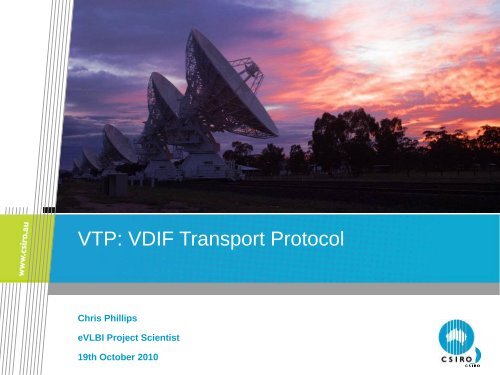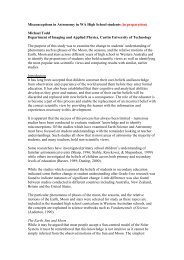Create successful ePaper yourself
Turn your PDF publications into a flip-book with our unique Google optimized e-Paper software.
<strong>VTP</strong>: <strong>VDIF</strong> <strong>Transport</strong> <strong>Protocol</strong><br />
Chris Phillips<br />
eVLBI Project Scientist<br />
19th October 2010
Introducing <strong>VDIF</strong><br />
CSIRO. <strong>VTP</strong><br />
<strong>VDIF</strong> is intended as a VLBI data interchange format<br />
usable for both real-time e-VLBI and non-real time<br />
data file formats<br />
Essentially any time based data – e.g. Pulsar<br />
baseband data<br />
Frame based format with each frame self-identifying<br />
and time tagged<br />
Supports multi-bit data as well as multiple channels in<br />
one frame or multiple parallel streams of 1 or more<br />
channels<br />
Format ratified at eVLBI2009 in Madrid
<strong>VDIF</strong> Frame Format<br />
CSIRO. <strong>VTP</strong><br />
Each Data Frame 32 byte header followed by<br />
data array of user specified length<br />
Up to one second in length<br />
Number of Data Frames/second must be an<br />
integer<br />
Data Frame may NOT span a second<br />
boundary<br />
Data Frame length must be a multiple of 8<br />
bytes
<strong>VDIF</strong> Frame Format<br />
CSIRO. <strong>VTP</strong><br />
Frame Header contains<br />
Time in seconds, frame number within<br />
second<br />
# channels & bits. “Complex” flag<br />
Station ID, Thread ID, Frame length
VIDF Usage<br />
CSIRO. <strong>VTP</strong><br />
DIFX has partial support for <strong>VDIF</strong><br />
No support yet for multiple threads<br />
SFXC supports <strong>VDIF</strong><br />
LBADR has experimental support for <strong>VDIF</strong><br />
Mark5a <strong>VDIF</strong> conversion software<br />
written<br />
Wettzell Tsukuba data transfer for<br />
rapid UT1-UTC determination uses <strong>VDIF</strong><br />
eVLA tied array output will be <strong>VDIF</strong>
<strong>VTP</strong>: <strong>VDIF</strong> <strong>Transport</strong> <strong>Protocol</strong><br />
CSIRO. <strong>VTP</strong><br />
<strong>VDIF</strong> defines the format of VLBI data but does not<br />
say how we move them from one location to another<br />
<strong>VTP</strong> defines how the frames are sent “down the<br />
wire”<br />
Relevant for<br />
Digital BBC Recorder (e.g. RDBE Mark5C)<br />
Realtime eVLBI<br />
Disk to correlator, using network transport
<strong>VTP</strong> Team<br />
CSIRO. <strong>VTP</strong><br />
Chris Phillips, CSIRO (chair)<br />
Alan Whitney, MIT Haystack<br />
Mark Kettenis, JIVE<br />
Mamoru Sekido, Kashima Space Research Center/CRL<br />
Richard Hughes-Jones, Dante
<strong>VTP</strong>: Status<br />
CSIRO. <strong>VTP</strong><br />
Not a huge amount of progress, no proposal<br />
ready to be endorsed
<strong>VTP</strong>: TCP<br />
CSIRO. <strong>VTP</strong><br />
TCP supports connection oriented “reliable”<br />
stream<br />
Bytes guaranteed to arrive in-order<br />
No further formatting is required. <strong>VDIF</strong><br />
frames are sent directly down wire to<br />
receiver<br />
Same approach for any other<br />
reliable/connection oriented protocol
<strong>VTP</strong>: UDP<br />
CSIRO. <strong>VTP</strong><br />
UDP does not guarantee delivery of packets or<br />
in-order arrival<br />
<strong>VDIF</strong> header contains enough detail to<br />
resemble frame order, but cannot distinguish<br />
packets dropped on network from packets<br />
never sent<br />
<strong>VDIF</strong> supports burst mode transmission<br />
Preface each <strong>VDIF</strong> frame with 64 bit sequence<br />
number<br />
Sequence number starts at 0
<strong>VTP</strong>: UDP continued<br />
CSIRO. <strong>VTP</strong><br />
One <strong>VDIF</strong> frame per UDP datagram<br />
Strongly encourage single UDP datagram per underlying<br />
layer (e.g. don’t fragment over multiple Ethernet frames)<br />
Each network stream to use unique sequence numbers<br />
“Stream” defined Source & destination IP address and<br />
destination port<br />
Either one thread per Stream or multiple thread per<br />
stream<br />
Same approach for other “unreliable” transport<br />
mechanisms – e.g. raw Ethernet
Packet Flooding<br />
CSIRO. <strong>VTP</strong><br />
Single direction UDP flows have the habit of<br />
flooding networks<br />
Receiver MAC address/physical port gets<br />
forgotten by switch<br />
Requires receiver to send occasional packet<br />
Proposal to combine with receiver statistics<br />
Once per second<br />
# frames received, out-of-order statistics etc
Next Step<br />
CSIRO. <strong>VTP</strong><br />
Define “ACK” scheme<br />
Finalize draft specification and distribute to<br />
community
CSIRO Astronomy and Space Science<br />
Chris Phillips<br />
eVLBI Project Scientist<br />
Phone: +61 2 9372 4608<br />
Email: Chris.Phillips@csiro.au<br />
Web: www.atnf.csiro.au/vlbi<br />
Thank you<br />
Contact Us<br />
Phone: 1300 363 400 or +61 3 9545 2176<br />
Email: enquiries@csiro.au Web: www.csiro.au








